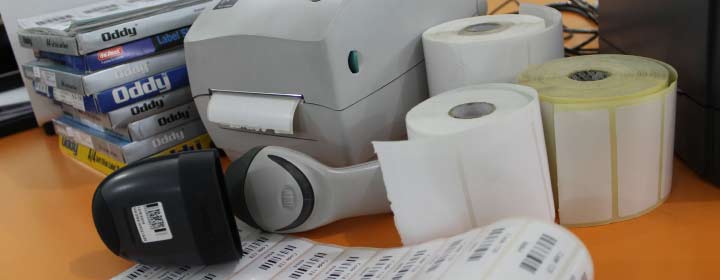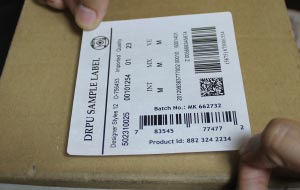Choose Correct Label for your Application
Barcodes come in a variety of shapes and sizes, each with its own set of advantages and disadvantages. It will be challenging to choose which barcodes will work best with your Application from such a large number of barcodes. Most importantly, barcodes can help your company with the highest level of efficiency and profitability.
We're proud to assist agencies in maximizing the benefits of barcode technology here at Company. Let's look at some important 1D and 2D barcode kinds for Users to assist you find the best solution for your team when it comes to choosing the Right barcode types. We'll highlight the most common applications for each barcode type.
📦Shape- It is one of the most important elements to consider when selecting a barcode label. Rectangle, rounded rectangular, and ellipse barcode label shapes are the best barcode label shapes, so put the barcode labels in an obvious and unobstructed location where the employees can see them easily.
📏Size- One of the most crucial variables to consider is the label's dimensions, but it's also important to examine the size if you want to optimize your savings. Many products have small labels, but they should not be too small because they are difficult to scan. Although the size of barcode labels varies from product to product and company to firm, it is critical to determine the optimal label size.
⭐Follow Specified Barcode Standards- You may need to check that your barcodes are approved by other companies along the supply chain in some circumstances. Maybe even the entire world. This implies that the print quality, bar height, colour, and backdrop of your barcode, as well as its placement on the label or container, must all comply with specified guidelines.
🎨Color- The standard color combination for bar-coding is a black barcode printed on a white label because it is easy for scanners to read. However, some industries allow you to create colorful labels, which compromise the readability of barcode labels.
🖨️Print High Contrast Barcode- Scanning high-contrast prints is easy. Light-colored barcodes should be avoided on light-colored backgrounds, and dark barcodes should be avoided on dark backgrounds. Certain color combinations of barcodes are also extremely undesirable (e.g. red on white or black on blue). A black barcode on a white, non-transparent background provides the best contrast.
Business Barcode Maker Software is user-friendly and simple to use, allowing users to create printable, custom, and scannable barcode labels, stickers, or asset tags using a variety of barcode fonts including Databar, Databar EAN 13 code, ISBN 13, PDF417, DataMatrix, QR Code, MICR code, and many others. This software generates barcode labels in a variety of sizes, bar widths, densities, and heights, as well as allowing you to personalise your labels with a logo, design, and colour scheme. Using the Sequential, Random, and Constant List Generating methods, this software allows you to create barcode labels in bulk. You may also use the software to produce barcodes from Excel sheets that contain barcode values.
QR codes are most commonly used in tracking and advertising campaigns, such as ads, publications, and business cards. Even though they can't be examined with a laser scanner, they're adaptable, have a high fault tolerance, and are easy to read. They can be scanned on almost any system that has scanning capability, and they can encode almost any type of data.
Industry: Entertainment and Advertising
In the logistics and transportation industries, Code 128 barcodes are utilized for ordering and distribution. All characters in the American Standard Code for Information Interchange 128 list will be encoded. These barcodes can hold a large amount of linear data, making them suitable for determining the contents of transported or packed containers and items.
Industry: Logistics
Barcodes with the code 39 are used to label products in a variety of businesses, including the automotive industry and the United States Department of Defense. It allows for the use of all digits and characters. It's only capable of encoding 39 characters. Code39 is still a popular and adaptable option because it eliminates the need for a check digit and can be read by almost any barcode reader.
Industry: Automotive and Defense
The Code 93 barcode, which can read both letters and numbers, is an upgraded, more secure, and compact version of the Code 39 barcode. Because of the additional characters in Code 93, it is a more compact and safe alternative to Code 39. Its tiny size and data redundancy make it suitable for usage in a variety of industries, including automotive, retail, and logistics.
Industry: Manufacturing
A UPC, or universal product code, is a form of code that is printed on retail product packaging to assist in the identification of a specific item. It consists of two parts: a machine-readable barcode comprised of a series of distinct black bars, and a 12-digit number below it.
Industry: Retail
Images, fingerprints, and signatures are all examples of functions that require significant amounts of data to be stored in PDF417 codes. They'll store more than 1.1 KB of machine-readable data, making them far more useful than traditional 2d barcodes.
Industry: Government
The transportation industry frequently use Aztec codes, particularly for tickets and airline boarding permits. Even if the barcodes are of poor quality, they can be read, which is useful when tickets are printed poorly or presented on a phone. They can also save space because they don't require a blank "quiet zone" around them, unlike certain other 2D barcode types.
Industry: Transportation
Codabar barcodes are used by logistics and healthcare professionals, as well as picture studios and libraries. It's easy to print them. Codabar can encode up to 16 characters, including four start and stop characters. Codabar barcodes provide several advantages, including easy scanning and self-checking, which decreases errors once the code is entered.
Industry: Healthcare and Education

Label Material: Barcode labels are available in a variety of materials, including paper, synthetic, and metallic. Consider the application and environment where the labels will be used and choose a material that is suitable for the conditions, such as resistance to water, heat, chemicals, or abrasion
Adhesive: Look for a label with a suitable adhesive that can adhere to the surface where the label will be applied, such as permanent or removable adhesive, depending on the application
Label Size: Choose a label size that is appropriate for the barcode symbology and the information that needs to be included, while also fitting within the available space.
Barcode Symbology: Consider the type of barcode symbology that will be used, such as UPC, Code 39, or QR code, and choose a label that is compatible with the symbology and can produce high-quality and readable barcodes.
Label Color: Choose a label color that provides sufficient contrast with the barcode symbology to ensure accurate scanning and readability.
Print Technology: Consider the print technology that will be used to print the barcode labels, such as thermal transfer or direct thermal, and choose a label that is compatible with the print technology.
Volume: Determine the volume of labels needed and consider buying in bulk to reduce costs.
Supplier: Choose a reputable supplier that can provide high-quality labels, with consistent quality and timely delivery.
→ Overall, the factors to consider when choosing barcode labels depend on the specific application and environment where the labels will be used, as well as the type of printer and print technology used to produce the labels. It's important to evaluate different options and consult with experts to ensure that the labels meet your requirements and provide accurate and reliable scanning.
It depends on the type of label and adhesive used. Some barcode labels are designed to be permanent and may be difficult to remove or reposition without damaging the label or the item it is applied to. Other barcode labels may have a removable adhesive that allows them to be easily repositioned or removed without leaving residue. It is important to choose the right type of label for your specific application to ensure it can be easily removed or repositioned if needed.
The benefits of using barcode labels include:
-
Increased Efficiency
Barcode labels can help to speed up processes by reducing the time it takes to manually input data. With a barcode scanner, information can be quickly and accurately entered into a system, reducing the risk of errors and saving time.
-
Improved Accuracy
Barcode labels ensure that data is accurately entered into a system, reducing the risk of errors and increasing the accuracy of inventory counts, pricing, and other critical data.
-
Cost-Effective
Barcode labels are an affordable and cost-effective solution for businesses of all sizes, allowing them to easily and quickly implement a system that can improve efficiency and accuracy.
-
Better Inventory Management
Barcode labels make it easier to track inventory, including quantities, locations, and movement, helping businesses to better manage their stock and reduce the risk of stockouts and overstocks.
-
Enhanced Customer Service
Barcode labels can help to improve customer service by enabling businesses to quickly and accurately track orders and shipments, providing customers with up-to-date information on their orders and reducing the risk of errors or delays.
